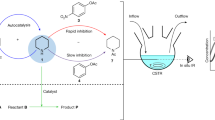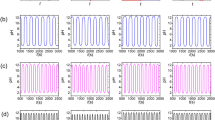Abstract
Concentration oscillations are ubiquitous in living systems, where they involve a wide range of chemical species. In contrast, early in vitro chemical oscillators were all derived from two accidentally discovered reactions1,2,3 based on oxyhalogen chemistry. Over the past 25 years, the use of a systematic design algorithm4,5, in which a slow feedback reaction periodically drives a bistable system in a flow reactor between its two steady states, has increased the list of oscillating chemical reactions to dozens of systems. But these oscillating reactions are still confined to a handful of elements that possess multiple stable oxidation states: halogens, sulphur and some transition metals6. Here we show that linking a ‘core’ oscillator to a complexation or precipitation equilibrium can induce concentration oscillations in a species participating in the equilibrium. We use this method to design systems that produce periodic pulses of calcium, aluminium or fluoride ions. The ability to generate oscillations in elements possessing only a single stable oxidation state (for example, Na+, F-, Ca2+) may lead to reactions that are useful for coupling to or probing living systems, or that help us to understand new mechanisms by which periodic behaviour may arise.
This is a preview of subscription content, access via your institution
Access options
Subscribe to this journal
Receive 51 print issues and online access
$199.00 per year
only $3.90 per issue
Buy this article
- Purchase on Springer Link
- Instant access to full article PDF
Prices may be subject to local taxes which are calculated during checkout





Similar content being viewed by others
References
Bray, W. C. A periodic reaction in homogeneous solution and its relation to catalysis. J. Am. Chem. Soc. 43, 1262–1267 (1921)
Belousov, B. P. A periodic reaction and its mechanism. In Sbornik Referatov po Radiatsionni Meditsine 145 (Medgiz, Moscow, 1958)
Zhabotinsky, A. M. Periodic kinetics of oxidation of malonic acid in solution. Biofizika 9, 306–311 (1964)
Epstein, I. R., Kustin, K., De Kepper, P. & Orbán, M. Oscillating chemical reactions. Sci. Am. 248, 112–123 (1983)
De Kepper, P., Kustin, K. & Epstein, I. R. A systematically designed homogeneous oscillating reaction: the arsenite–iodate–chlorite system. J. Am. Chem. Soc. 103, 2133–2134 (1981)
Sagués, F. & Epstein, I. R. Nonlinear chemical dynamics. Dalton Trans., 1201–1217 (2003)
Orbán, M., De Kepper, P. & Epstein, I. R. Minimal bromate oscillator: Bromate–bromide–catalyst. J. Am. Chem. Soc. 104, 2657–2658 (1982)
Richter, P. H. & Ross, J. Concentration oscillations and efficiency: Glycolysis. Science 211, 715–717 (1981)
Harris, D. C. Quantitative Chemical Analysis 5th edn 312–313 (Freeman, New York, 1999)
Edblom, E. C., Luo, Y., Orbán, M., Kustin, K. & Epstein, I. R. Kinetics and mechanism of the oscillatory bromate–sulfite–ferrocyanide reaction. J. Phys. Chem. 93, 2722–2727 (1989)
Rábai, G., Orbán, M. & Epstein, I. R. Design of pH-regulated oscillators. Acc. Chem. Res. 23, 258–263 (1990)
Berridge, M. J. Calcium oscillators. J. Biol. Chem. 265, 9583–9586 (1990)
Szucs, A. et al. Interacting biological and electronic neurons generate realistic oscillatory rhythms. Neuroreport 11, 563–569 (2000)
Acknowledgements
This work was supported by the Hungarian Academy of Sciences (HAS), the US National Science Foundation (NSF) and a US-Hungarian Cooperative Research Grant from NSF and HAS. We thank L. Yang for assistance in preparing the figures.
Author information
Authors and Affiliations
Corresponding author
Ethics declarations
Competing interests
The authors declare that they have no competing financial interests.
Rights and permissions
About this article
Cite this article
Kurin-Csörgei, K., Epstein, I. & Orbán, M. Systematic design of chemical oscillators using complexation and precipitation equilibria. Nature 433, 139–142 (2005). https://doi.org/10.1038/nature03214
Received:
Accepted:
Issue Date:
DOI: https://doi.org/10.1038/nature03214
This article is cited by
-
A catalytically active oscillator made from small organic molecules
Nature (2023)
-
Non-autonomous zinc–methylimidazole oscillator and the formation of layered precipitation structures in a hydrogel
Scientific Reports (2023)
-
Network dynamics of a periodically forced chemical system and its application for tuning PID controller with time-delay systems
Nonlinear Dynamics (2023)
-
Recent advances in the temporal and spatiotemporal dynamics induced by bromate–sulfite-based pH-oscillators
Reaction Kinetics, Mechanisms and Catalysis (2022)
-
Belousov-Zhabotinsky type reactions: the non-linear behavior of chemical systems
Journal of Mathematical Chemistry (2021)
Comments
By submitting a comment you agree to abide by our Terms and Community Guidelines. If you find something abusive or that does not comply with our terms or guidelines please flag it as inappropriate.



